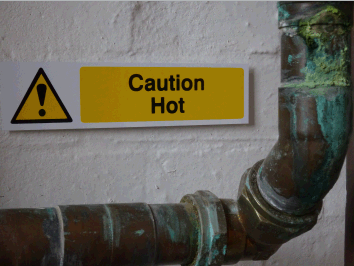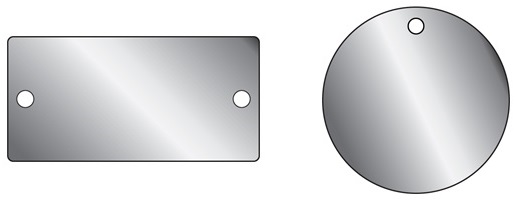There are instances and locations where there are space restrictions on using the standard size ranges of safety signs. These simply will not fit. So, our range of mini safety signs has been designed to overcome such problems.
These small format signs, in a full range of safety sign classifications, come in a size of 50mm x 200mm, and are manufactured in pvc with an adhesive backing for easy use. All these signs comply with ISO 1710 and the Safety Sign and Signals Regulations 1996.

They cover a comprehensive range of safety requirements including;
Fire equipment signs for pinpointing the location of fire extinguishers, fire alarms and fire points.
Mandatory signs can be used to indicate the use of personal protective equipment, the use of guards on equipment, as well as access points such as fire doors, housekeeping, and personal hygiene.
Prohibition safety signs cover restrictions on smoking, drinking water, access, and use of mobile phones.
Safe condition safety signs determine fire emergency access points and escape routes, the location for first aid, emergency stop cut off points and drinking water.
Hazard warning safety signs identify the risks and dangers from electricity (electric shock, high voltage), from hazardous substances (toxic, harmful chemicals), and physical hazards such as slips, trips, and falls and scalds from hot water.
These products have been used in a wide variety of office, commercial and industrial locations to assist in complying with health and safety guidelines, and providing employees, customers and the general public with visible safety information.

Our metal nameplates and tags come in a variety of different materials, including brass, steel, and anodised aluminium. This variety is important to us - we take great pride in providing a labelling solution for any requirements, and by stocking several different metals, we are able to cater to a far wider range of customers than most other suppliers.
Today, however, we'd like to focus on one material in particular: stainless steel. While it's not the perfect choice for every situation - if it were, we wouldn't stock those other options mentioned above - we do feel that it's a very versatile option that's very well-suited to most applications. Here are a few reasons to choose stainless steel for your tags and nameplates:
- Made of 316 marine grade stainless steel
- Resistant to stains and chemicals
- Suitable for use in extreme temperatures
- Ideal for salt water environments
- Suitable for marking valves, pipes, tools and plant
- Supplied in 304 grade stainless steel
- 0.5mm thick (24 swg)
- Chemical- and stain-resistant
- Suitable for a wide range of temperatures
- Available in a variety of sizes
- Able to be sterilised
- Equipped with drill holes and self-adhesive backing for easy fixing
- Ideal for the labelling of equipment and machinery
Visit our Metal Nameplates and Metal Tags pages to see more of Label Source's range.

PPE (Personal Protective Equipment) is a crucial consideration in many different industries. Doctors (who are frequently at risk of infection) and builders (who face any number of hazards over the course of a working day) are obvious examples, but PPE isn't just something for the medical and construction industries to worry about - protective equipment is used practically everywhere, from fire and police stations to warehouses and post offices.
Sadly, the requirement for PPE is one that's all too often forgotten by employers and their staff. It's easy to dismiss protective equipment as yet more 'red tape' that gets in the way of one's job, but the truth of the matter is that PPE saves lives - without it, your employees are at risk, and you and your business are liable for any damages.
Here are some sobering case studies from a variety of different industries:
Nurse sues hospital company after contracting Ebola
If Nina Pham's name sounds familiar to you, it's probably because her story was one of the biggest of last year's Ebola outbreak. Ms Pham was the first person to contract the disease on American soil, and though she fortunately recovered the illness, she has since filed a lawsuit against her employer, Texas Health Resources, on the grounds that they didn't to enough to protect her from infection. The lawsuit states that the company did not adequately train employees to avoid exposure; furthermore, they did not provide the correct protective equipment, which meant that Nina Pham's neck and hair were exposed whilst treating an infected patient.
Worker paralysed after three-metre fall
A 34-year-old man named Colin Shields was left paralysed from the neck down after suffering a fall at work. Mr Shields fell 3 metres from the top of a gritter; the Health & Safety Executive fined his employer, Inex Works Ltd, £13,500 for breaching the Work at Height Regulations 2005. A press release on the HSE website suggested that Mr Shields ought to have been "wearing a harness or restriant to protect him from falling".
Narrow escape for man hit by falling guttering
Valentin Taljanov (aged 61 at the time of the incident in question) was seriously injured after a piece of cast iron guttering fell onto him at Aberdeen Harbour, where he was working at the time. Mr Taljanov suffered a broken arm, a punctured lung, and multiple other injuries, although the damage could potentially have been even worse; an HSE press release stated that "it was probably only Mr Taljanov's hard hat that prevented him from being killed".
Hopefully, these three stories have more than convinced you of the importance of PPE. If you are an employer, be sure to train your workers properly, and put up the proper PPE signs to remind them of their responsibilities at all times!
We sell a range of RoHS labels here at Label Source. But what does it actually mean to be 'RoHS compliant'? Allow us to answer your questions...
What does 'RoHS' stand for?
Restriction of Hazardous Substances, which is itself shorthand for the directive's full title: Directive on the restriction of the use of certain hazardous substances in electrical and electronic equipment.
What is the RoHS directive?
A legal act of the European Union (EU) that first came into force in 2003. When it took effect, the RoHS directive placed severe restrictions on the use of six potentially hazardous materials in consumer electronics and electrical equipment.
What materials are prohibited by RoHS?
The following materials are prohibited (with some expections):
This means that, in most cases, goods containing any of the above substances cannot be sold to the general public.
How do I comply with the RoHS directive?
In a nutshell: you must not manufacture, import, or sell any products that contravene RoHS regulations. If any of your products contain lead, mercury, or any of the other substances listed above, you may well be in breach of the RoHS, which means that you could be vulnerable from a legal standpoint. Ignorance is not a valid defence; you must be able to prove that you have taken all reasonable measures to comply with the RoHS directive.
How can Label Source help with this?
As mentioned above, we sell a huge range of RoHS labels for manufacturers and retailers to use with their products. Some of the labels indicate that the labelled product is, for example, lead-free (and hence compliant); others are designed to indicate the presence of restricted materials for environmental and safety purposes. We also offer WEEE labels and China RoHS labels, both of which are closely related to the Restriction of Hazardous Substances directive and may indicate compliance by association.
Click here to browse our full range of RoHS/WEEE labels.
Earlier this month, the Health Service Journal published a report on the current state of patient safety in the NHS. Entitled The Case for Patient Safey: Financially, Professionall and Ethically, it is a wide-ranging report that covers a number of different concerns; however, one point in particular stands out:
"[T]here's a long list of clinical risks where, seen through the lens of patient safety, we have to act, and the NHS can be a world leader. There are still enormous improvements to be had from improvements in areas such as sepsis and acute kidney injury. And one of the biggest threats facing all healthcare systems, anti-microbial resistance, needs to be comprehensively tackled as an emerging patient safety threat."
Today, we'd like to tell you how you can personally help to prevent the spread of anti-microbial resistance with the UK and its National Health Service. But first...
What IS anti-microbial resistance?
The World Health Organisation (WHO) defines anti-microbial resistance as the "resistance of a microorganism to an antimicrobial drug that was originally effective for treatment of infections caused by it". In layman's terms: once scientists have found the cure for a particular disease, that disease may - over time - build up a resistance to the cure. This is called 'anti-microbial resistance'.
Why is this a problem?
Because infections will pose a far more serious threat to human life if they become resistant to antimicrobial treatments. Illnesses that are currently treatable may eventually become life-threatening if their anti-microbial resistance builds up.
What can I do about it?
We're glad you asked! The following actions are recommended by the WHO itself - here's what you personally can do to tackle anti-microbial resistance:
- Wash your hands. This simple act is the single best way to prevent the spread of infectious diseases - you should always wash after using the toilet, preparing food, sneezing/coughing into your hands, or otherwise coming into contact with something that could carry infection (e.g. animals, refuse, wounds).
- Avoid contact with sick people if possible. This one is just common sense: the less time you spend around an infection, the less likely you are to be infected.
- Practise safe sex. Condoms are the most effective way to prevent the spread of sexually-transmitted infections; while other contraceptives (such as the pill or an IUD coil) will minimise the risk of pregnancy, these methods do nothing to prevent infection.
- Ensure that you are properly vaccinated. This also goes for any children in your care, as well as for vulnerable elderly relatives who may need your assistance to get their vaccinations.
- Do not use anti-microbial drugs unless prescribed. Just as vaccinations help you to build up a resistance to certain diseases, unprescribed use of anti-microbial drugs may help infections to build up a resistance to these treatments.
- If your doctor prescribes anti-microbial drugs, be sure to finish the full treatment course. Even if you feel better after a few doses, it is important to take the full recommended treatment.
Of course, if you work in a hospital, clinic, or any other healthcare environment, you may be able to prevent anti-microbial resistance in other ways. For example, you can ensure that your building has plenty of signs that remind people to wash their hands, dispose of clinical waste properly, and so forth. Education is an important of any safety programme, and now that you know how to prevent anti-microbial resistance, you can educate others, both via safety signs and by word of mouth.